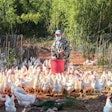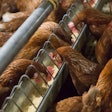
A fire broke out at one of Oakdell Egg Farms’ facilities in Cache County, Utah on April 23rd, 2024.
The fire started around 4 P.M. and lasted several hours. While no employees or firefighters were injured during the event, all 120,000 layers housed in the building were lost. Additionally, the building was not salvageable.
Firefighters were able to contain the fire to only one house despite the water supply being limited due to the facility’s location. Because of the fire’s size, firefighters from every department in the area were dispatched.
Cache County Fire Marshal Jason Winn told news outlet Cache Valley Daily that the 20,000 ft. house was made of wood with a tin roof and that the cause of the fire is still under investigation.
Oakdell Egg Farms operates in conjunction with Ritewood Egg Farm and has farms located in Idaho, Washington and Utah. It produces organic, cage-free, nutritionally enhanced and conventional eggs that are sold in 11 states.
Are farm fires causing prices to increase in the U.S.?
Some consumers have the perception that poultry farm fires are causing the price of chicken and eggs to increase.
Farm fires reduce the number of layers available, subsequently decreasing the supply of eggs. While reducing the supply of eggs can make egg prices increase, farm fires are not the blame of current rising prices in the U.S.
The cause of inflated prices is attributed to highly pathogenic avian influenza (HPAI) outbreaks occurring on five U.S. egg farms in 2024 as of April 24th, causing approximately 9.5 million layers to be depopulated, according to the U.S. Department of Agriculture’s (USDA) Animal Plant Health Inspection Service (APHIS).
However, egg prices are not expected to climb as high as they did approximately one year ago due to a lesser number of outbreaks and U.S. egg producers increasing the number of birds in stock to prepare for potential outbreaks.


















